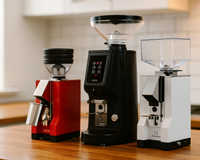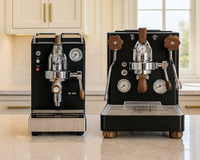Is espresso less acidic than coffee?
Coffee lovers often debate the merits of different brewing methods, including drip coffee and espresso. One of the factors that is frequently discussed is the acidity of these beverages. While some people believe that espresso is less acidic than coffee, others argue that the opposite is true. So, which is it? In this post, we'll explore the question of whether espresso is less acidic than coffee. We'll delve into the science behind acidity in coffee and explain the differences between coffee and espresso.
The Verdict: Yes, generally speaking, espresso is less acidic than coffee.
The acidity of coffee and espresso is determined by a variety of factors, including the type of beans used, the roast level, and the brewing method. However, because espresso is brewed under high pressure and in a short amount of time, it tends to have less acidity than drip coffee. Additionally, espresso is often made with a darker roast, which can also contribute to lower acidity levels. Keep in mind that individual preferences and coffee brewing methods can also impact the perceived acidity of coffee and espresso.
Understanding Acidity in Coffee
Acidity is a key characteristic of coffee that contributes to its flavor profile. It refers to the perceived tartness, brightness, or sourness of the coffee, which can range from mild to pronounced. Acidity is not the same as pH, which measures the concentration of hydrogen ions in a solution, but rather a complex combination of organic acids, such as citric, malic, and tartaric acids, that are naturally present in coffee beans. These acids give coffee its unique flavor and aroma, and contribute to the overall sensory experience of drinking coffee.
However, the level of acidity in coffee can vary depending on a number of factors, including the variety of coffee bean, the altitude at which it was grown, the processing method, and the roast level. Some coffee drinkers prefer low-acid coffee, while others enjoy a more acidic brew.
There are several factors that affect acidity levels in coffee:
-
Coffee Bean Variety: Different coffee bean varieties have different levels of acidity. For example, beans from Ethiopia tend to be more acidic than beans from Brazil.
-
Altitude: Coffee plants grown at higher altitudes tend to produce beans with higher acidity levels. This is because the cooler temperatures and slower growing conditions allow the beans to develop more complex flavors.
-
Processing Method: The way that coffee beans are processed can also affect their acidity levels. Beans that are wet-processed, which involves removing the outer layer of the fruit before drying the beans, tend to be more acidic than beans that are dry-processed, which involves drying the beans with the fruit still intact.
-
Roast Level: The roast level of coffee beans can also impact acidity. Lighter roasts tend to have higher acidity levels, while darker roasts tend to have lower acidity levels.
-
Brew Method: The method used to brew coffee can also impact its acidity. For example, coffee brewed using a drip method tends to have higher acidity levels than coffee brewed using a French press.
By understanding these factors, coffee drinkers can better appreciate the nuances of acidity in their cup of coffee and make informed choices about the beans they choose and the brewing methods they prefer.
The Difference Between Coffee and Espresso
When it comes to the world of coffee, there are many different brewing methods to choose from, but two of the most popular are coffee and espresso.

How coffee is brewed:
Coffee can be brewed using a variety of methods, but one of the most common is drip brewing. This method involves pouring hot water over ground coffee beans that have been placed in a filter, which allows the water to slowly drip through the coffee and into a carafe below. The resulting brew can be adjusted to taste by varying the coffee-to-water ratio, grind size, and brewing time. Other popular methods for brewing coffee include French press, pour-over, and cold brew.
How espresso is brewed:
Espresso is a unique brewing method that uses high pressure and finely ground coffee to produce a concentrated shot of coffee. To make espresso, finely ground coffee beans are tightly packed into a small metal filter basket called a portafilter. The portafilter is then locked into an espresso machine, which forces hot water through the grounds under high pressure. The result is a small but strong shot of coffee with a thick layer of crema on top. Espresso can be consumed on its own or used as a base for other coffee drinks, such as cappuccinos and lattes.
The chemical differences between coffee and espresso:
The main chemical difference between coffee and espresso lies in the brewing process. The high pressure and short brewing time of espresso results in a higher concentration of compounds that are responsible for flavor and aroma, such as caffeine, oils, and organic acids, compared to regular coffee. This is because the high pressure and heat extract more of these compounds from the coffee grounds. In contrast, coffee brewed using a drip or pour-over method has a lower concentration of these compounds and a lighter body. Additionally, the chemical makeup of espresso can vary depending on the type of coffee bean used, the roast level, and the brewing temperature and pressure.
The Benefits of Choosing Low-Acid Coffee or Espresso
Choosing a low-acid coffee or espresso can offer several benefits, including:
-
Reduced Risk of Acid Reflux: For people who are sensitive to acid or suffer from acid reflux, choosing a low-acid coffee or espresso can help reduce discomfort and symptoms.
-
Better Taste for Some: Some coffee drinkers find that low-acid coffee or espresso has a smoother, less bitter taste that they prefer.
-
Improved Digestion: High-acid coffee or espresso can sometimes irritate the stomach lining, leading to digestive discomfort or issues. Choosing a low-acid option can help alleviate these issues and promote better digestion.
-
Health Benefits: Some studies have suggested that low-acid coffee or espresso may have additional health benefits, such as reducing the risk of certain cancers, improving cognitive function, and lowering the risk of heart disease.
While low-acid coffee or espresso may not be the best option for everyone, it's worth considering if you have specific digestive or taste preferences or are looking for additional health benefits from your coffee or espresso.
Conclusion
In conclusion, the question of whether espresso is less acidic than coffee has several complex and interrelated factors at play. While espresso is generally considered to be less acidic than coffee due to its high-pressure brewing method and shorter contact time, individual preferences, brewing methods, and other factors such as roast level and coffee bean selection can also influence the perceived acidity of these popular beverages. Ultimately, the choice between coffee and espresso, as well as the acidity level of each, is a matter of personal taste and preference. By understanding the factors that affect acidity in coffee and espresso, however, coffee drinkers can make more informed choices about their favorite brew and appreciate the unique characteristics of each. Whether you prefer a bold, acidic coffee or a smooth, low-acid espresso, there is a brew out there for everyone.















